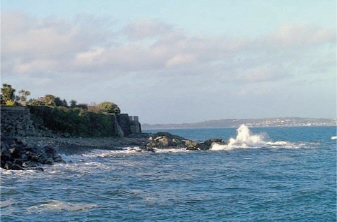
don’t paint all the details
When you look at a scene and focus, for example, on a tree in a field, you see the tree in sharp detail. However, while your eyes are focused on the tree, they perceive much less detail in other areas of the scene through your peripheral vision. Cameras, unlike your vision, record all detail evenly in the photograph. If you copy the photograph as you see it, it may look more like a photograph than a painting. Keeping the details minimized in areas other than the focal point helps lead the viewer’s eye to the focal point. The viewer will also perceive the painting more as he or she would see the scene in reality, lending a sense of believability to your artwork.

too much detail steals the focus
In this photograph, there are too many details visible in the distance, which would bring it forward and make it appear too close to the viewer if it was painted with the same detail. Too much clutter on the hillside takes the attention away from the breaking wave.
shoot with a painting in mind
Your camera can be your first compositional tool. Experiment with framing the scene in different ways—horizontal and vertical formats, zooming in and back out. Think about why you like the scene and what the most important element in it is as you take the photo. Make notes if you can; if that’s not possible, observe carefully and make mental notes. Having your painting goals in mind as you take photos will benefit your future paintings—and make you a better photographer!
The compositional decisions you make as you take photos are one reason it’s best to paint from your own photographs. If you use another person’s photos, then you’ve started with someone else’s composition—and in some cases, it can also be a copyright violation.
As an artist, you’ll continue to hone your visual memory for color and value, and with practice, you’ll find your memory of the actual scenes will return when you look at your photographs.

Cornish Coast
5" × 7" (13cm × 18cm)
simplify and adjust
Moving the wave to a more interesting position and minimizing details in other areas puts the focus on the breaking wave. The cliffs on the left are simplified, leaving out the small shapes of foliage and massing them together, and many of the rocks have been eliminated.